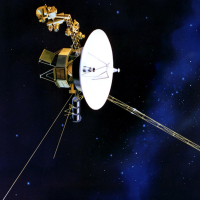First Man-Made Object Leaves the Solar System…35 Years after Launch
 Voyager 1 (photo: NASA)
Voyager 1 (photo: NASA)
Its technology predates everything from PCs to iPhones, and its memory capacity is almost laughable by today’s standards, but the Voyager 1 spacecraft is still going and accomplishing amazing feats—including becoming the first man-made object to leave the solar system.
Technically, Voyager 1 exited the bounds of this planetary system more than a year ago. But scientists took their time examining the information sent back from the spacecraft before deciding that it had, indeed, come in contact with the plasma of interstellar space. They marked the date when it had left-the-building as August 25, 2012.
Scientists are amazed by what Voyager 1 has done, having traveled 11.7 billion miles so far since launching in 1977.
“I don’t know if it’s in the same league as landing on the moon, but it’s right up there — ‘Star Trek’ stuff, for sure,” Donald A. Gurnett, a physics professor at the University of Iowa and the co-author of a paper published in the journal Science about Voyager’s mission, told The New York Times. “I mean, consider the distance. It’s hard even for scientists to comprehend.”
Another fact hard to comprehend is that it is still working and sending back data (which takes about 17 hours to reach earth). Consider this: It stores readings about cosmic rays, ionized gas and magnetic fields on an 8-track tape recorder, and its computers can process only about 8,000 instructions per second. In comparison, a typical smartphone can manage 14 billion instructions a second.
Voyager 1 was sent off 36 years ago to visit and take photos of Saturn. But it just kept going after that, traveling past the remaining planets in the solar system.
Scientists at the National Aeronautics Space Administration (NASA) say the little-craft-that-could has plenty of life left in it. They expect to continue receiving transmissions for another 12 years, as long as its 23-watt transmitter (think refrigerator light bulb in terms of power) keeps functioning.
Its next stop is a long way away, in terms of reaching another planetary system. That would be the dwarf star AC+793888 in the constellation of Camelopardalis. Even at its current speed of 38,000 miles an hour, Voyager 1 will take 40,000 years to reach it.
If it ever comes in contact with intelligent life, the spacecraft contains a disc known as “The Golden Record” filled with images from earth and spoken greetings in various languages as well as an “eclectic” mix of music.
NASA included printed instructions to help extraterrestrials figure out how to play the gold-plated phonograph record.
-Noel Brinkerhoff
To Learn More:
In a Breathtaking First, NASA’s Voyager 1 Exits the Solar System (by Brooks Barnes, New York Times)
At last, Voyager 1 Slips into Interstellar Space (by Andrew Grant, Science News)
NASA: Voyager 1 Probe Has Left the Solar System (by Alicia Chang, Associated Press)
Voyager 1 Just Left the Solar System Using Less Computing Power Than Your iPhone (by Caitlin Dewey, Washington Post)
Voyager: The Interstellar Mission (Jet Propulsion Laboratory)
- Top Stories
- Unusual News
- Where is the Money Going?
- Controversies
- U.S. and the World
- Appointments and Resignations
- Latest News
- Musk and Trump Fire Members of Congress
- Trump Calls for Violent Street Demonstrations Against Himself
- Trump Changes Name of Republican Party
- The 2024 Election By the Numbers
- Bashar al-Assad—The Fall of a Rabid AntiSemite






Comments